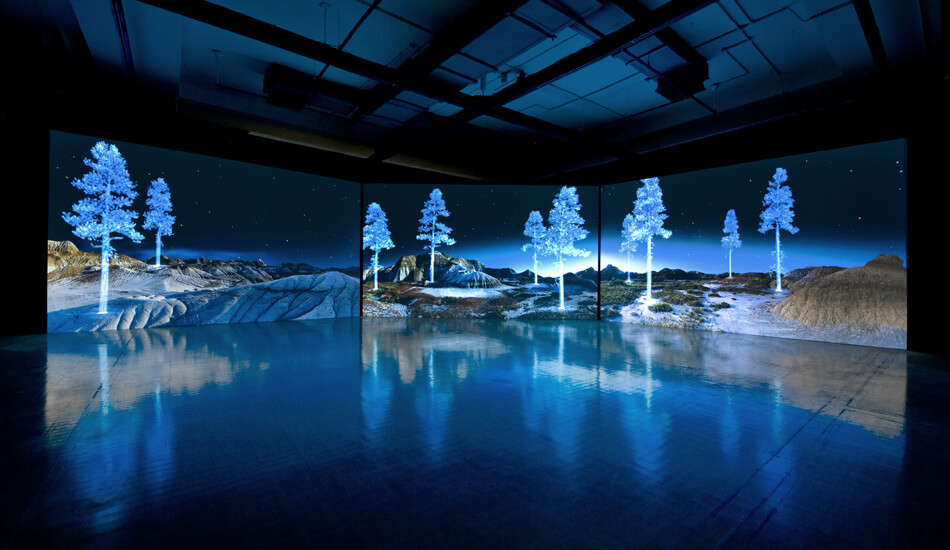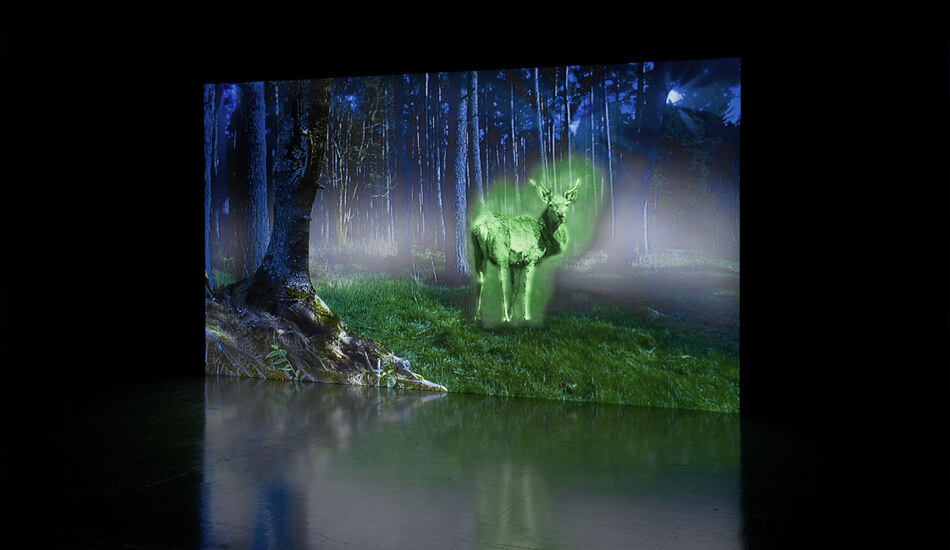PAINTERS ON PAINTINGS
Claire Scherzinger on Kelly Richardson

Kelly Richardson, The Erudition, 2010, 3 screen, HD video channel installation (with audio), 48’ x 9’ (variable)
Blue ghost trees sway gently in an unknowable wind on a desert night. On another screen a deer, tinged uranium green, walks through and stares back ominously. Shattered flaming fragments fall down on an unsuspecting landscape. Mars unfolds before you like a book as the dust wisps around old land rovers and probes.
You may cry. At least, this is a possibility when standing in front of Kelly Richardson’s large-scale hyper-realistic video landscapes. The sublime reveals itself; to stand in the gallery with Richardson’s work is much like being in a light-filled cathedral and feeling an incredible weightlessness as you look up towards the sun.

Kelly Richardson, Leviathan, 2011, 3 screen, HD video channel installation (with audio), 48’ x 9’ (variable)
Despite not being paintings themselves, the history of Romantic painting is deeply embedded within Richardson’s video works. It may come as no surprise that she used to paint, and eventually switched to making video in recognizing the limitations of painting. And yet, the influence of paint remains; she cites John Martin, the Romantic apocalypse painter, as a great source of inspiration.
Indeed, the size and scope, the drama and desire of Martin’s work could not be more relevant than it is today as we face the possibility of total environmental disaster. Rolling turbine masses of clouds and lightning strike and burn the horizon above scenes depicting the end of great civilizations. Richardson also imagines apocalyptic futures.

John Martin, The Great Day of His Wrath, 1851-53, Oil on canvas, 77.3 x 119.2 inches
Yet, where Richardson differs from Martin is in her approach to drama: the lack of human forms in the landscape and the subtlety in movement create a slow quietude where her restraint reveals an overwhelming sense of horror mixed with awe. Flora and fauna appear pristine, yet forever changed by the anthropocene, exemplified in the way the habituated deer directs its gaze upon the viewer in Twilight Avenger. Or in the way a luminous black and gold swath of water reminiscent of an oil spill covers a cypress tree forest in Leviathan. One can’t help but wonder if the viewer has become the object, or remains the subject in experiencing such works.

Kelly Richardson, Twilight Avenger, 2008, HD video channel installation (with audio), 16’ x 9’ (variable)
In all of this, perhaps the most important aspect of Richardson’s practice is how she takes both the most powerful parts of painting and its failures and transforms them into something on the edge of the ineffable. Her works become entities just above our heads, but forever in our minds. Part of this is achieved through absence, through the fleeting ethereal nature of the video medium. But there is also presence. What I mean by presence is that her work is a portal for the viewer to step into as the room transforms into a theatre of the mind.

Kelly Richardson, Mariner 9, 2012, 3 screen HD video channel installation (with audio), 43’ x 9’ (variable)
Accordingly, we become part of the presence and the absence of her work, creating spiritual distance from painting and our physical reality even as we are being engulfed by the world she’s built for us. As Timothy Morton writes in his pivotal book Ecology Without Nature, “the distance between the subject and object relationship is completely collapsed”[1] as we are enveloped in the ambience of Richardson’s lonely, future landscapes.
I feel that painting can, at times, achieve these heights of becoming something ineffable. An entity. However, I prefer to think of paintings now more as organisms on Earth, embedded with their own hopes and failures. They breathe; they live a life striving towards greatness, the same as we would hope for our children. Contrastingly, this spiritual distance and simultaneous envelopment in Richardson’s work is not a weakness. In fact, it is what makes her work so powerful: we all need something that makes us want to look up towards the light.

Claire Scherzinger, Dinner, 2017, Oil on canvas, 62 ½ x 46 inches
Claire Scherzinger has shown her paintings across Canada and internationally. She was a winner of the Royal Bank of Canada funded National Painting Prize in 2015 and is currently finishing an MFA at the University of Victoria. www.clairescherzinger.com
[1] Morton, Timothy. Ecology Without Nature: Harvard University Press, 2008.
